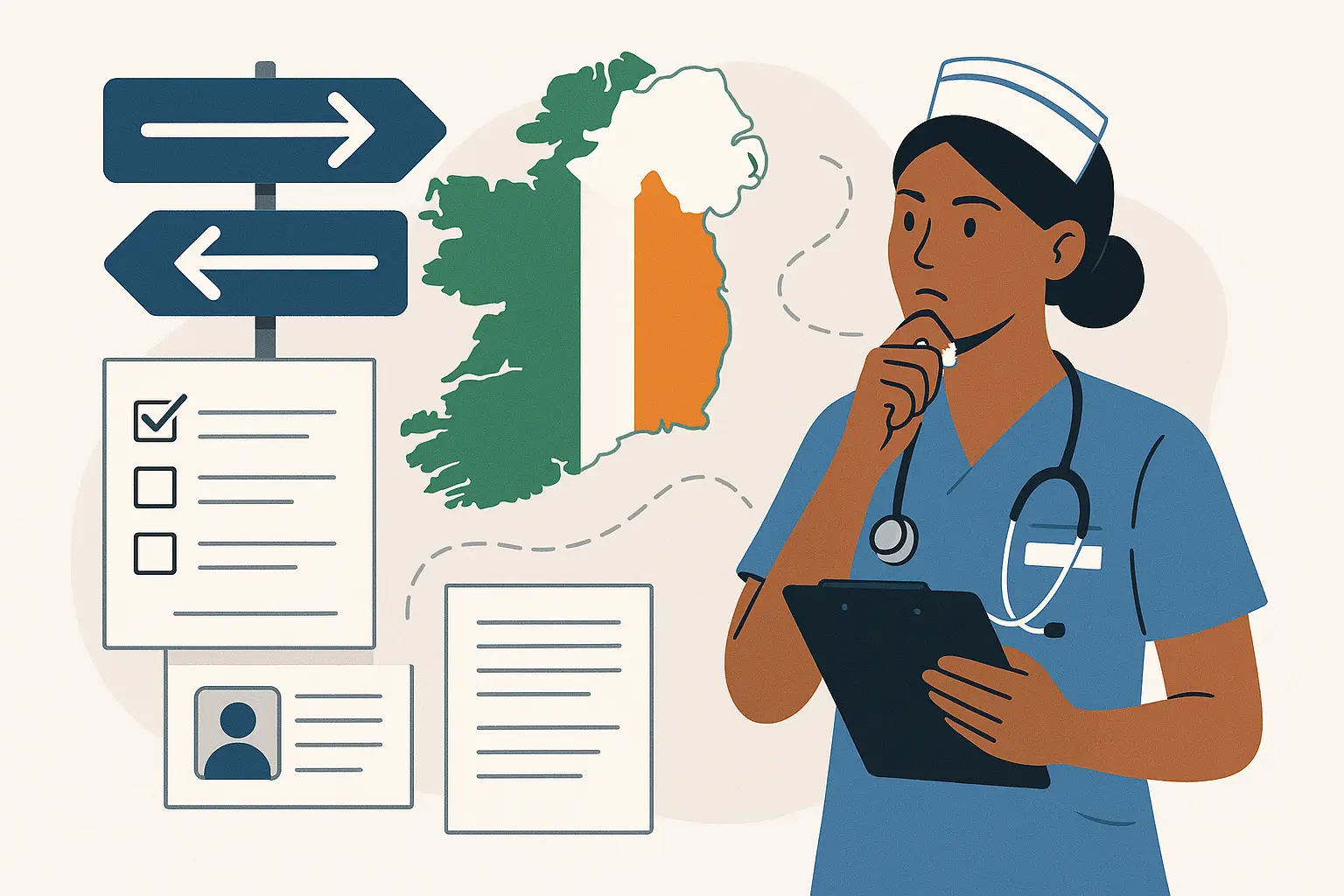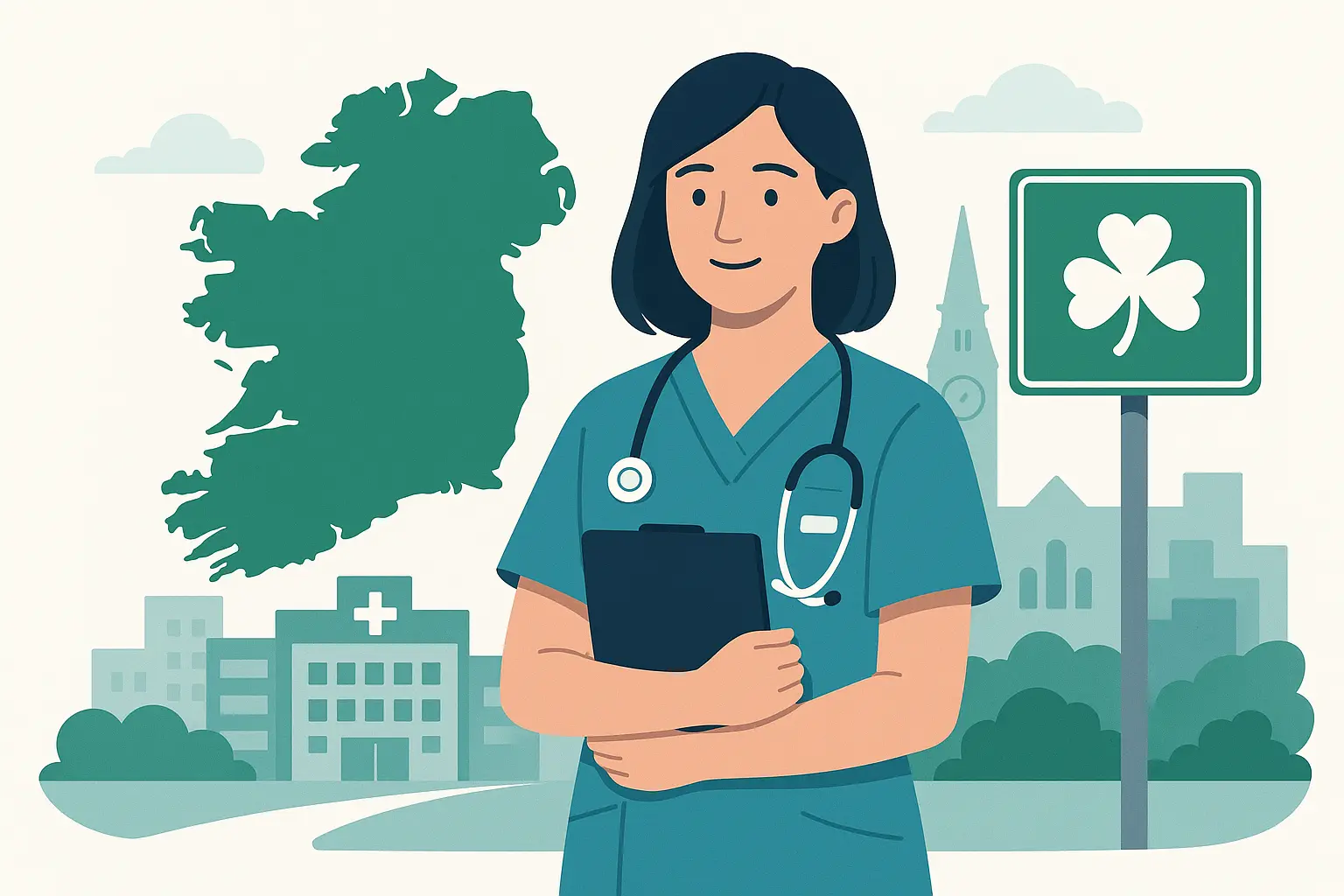A comprehensive guide for healthcare recruiters on successfully sourcing nurses for Irish hospitals. Learn to navigate the NMBI process, leverage the best job boards, and improve retention to tackle the nursing shortage in Ireland.
Introduction: Addressing the Urgent Need for Sourcing Nurses for Irish Hospitals

As a healthcare recruiter, you are on the front lines of one of the most critical challenges facing the Irish healthcare system today. The intense pressure to fill vacancies is immense, and you are an essential player in safeguarding patient care across the country. The significant nursing shortage Ireland continues to place unprecedented strain on hospitals and healthcare facilities, making your role more vital than ever. Simple, passive recruitment methods are no longer sufficient to meet this demand.
This article is your definitive, strategic guide to sourcing nurses for Irish hospitals. We move beyond basic job postings to provide a comprehensive masterclass in building a sustainable talent pipeline. We will navigate the complexities of Irish regulatory bodies, identify the most effective sourcing channels for both domestic and international talent, and explore how a focus on retention can make your recruitment efforts more successful and enduring. By implementing these strategies, you can transform your approach from reactive to proactive, securing the high-calibre nursing professionals Ireland urgently needs.
Section 1: Understanding the Landscape: The Pressing Nursing Shortage in Ireland

To effectively recruit, one must first grasp the full scale of the challenge. The nursing shortage Ireland is not a recent phenomenon, but it has reached a critical point. Reports from organisations like the Irish Nurses and Midwives Organisation (INMO) consistently highlight thousands of vacant nursing positions across the Health Service Executive (HSE) and private sector at any given time. This chronic understaffing is more than just a statistic; it has profound, real-world consequences for the nation’s healthcare infrastructure.
The direct impact of these vacancies is felt daily in Irish hospitals. It leads to increased patient-to-nurse ratios, which can compromise the quality and safety of care. It contributes to longer waiting times for essential procedures and emergency department admissions, creating public frustration and clinical risk. For the existing nursing workforce, the shortage fuels a cycle of burnout, overwork, and low morale, which in turn exacerbates staff turnover. This challenging environment demands a sophisticated, multi-channel, and ethically grounded approach to sourcing talent, which the remainder of this guide will meticulously detail.
Section 2: Navigating the Regulatory Maze: Recruitment of Overseas Nurses

For many recruiters, the most significant pool of potential candidates lies beyond Ireland’s borders. However, recruiting overseas nurses involves a complex web of regulatory, immigration, and professional standards. Mastering this landscape is non-negotiable for success. It allows you to guide candidates with confidence, reduce processing times, and position your organisation as a competent and trustworthy employer.
Subsection 2.1: The NMBI Registration Process for Overseas Nurses
The gateway for any nurse wishing to practise in Ireland is the Nursing and Midwifery Board of Ireland (NMBI). No nurse, regardless of their experience or origin, can legally work in Ireland without being registered with the NMBI. As a recruiter, understanding the intricacies of the NMBI registration process for overseas nurses is your first and most critical task. You must be able to articulate this journey clearly to your candidates and manage their expectations regarding the timeline and requirements.
The process is a multi-stage undertaking that requires careful preparation from the candidate. Here is a detailed breakdown you can use to guide them:
- Online Application & Fee Payment: The candidate creates an account on the MyNMBI portal. They complete the initial application form and pay the non-refundable assessment fee. This officially begins their registration journey.
- Comprehensive Document Upload: This is often the most demanding stage. Candidates must upload a suite of specific documents, which must be high-quality scans of the originals. If any documents are not in English, they must be accompanied by certified translations. Key documents include:
- Passport and/or other identity documents.
- Birth Certificate.
- Evidence of name change (if applicable).
- Professional qualification certificate(s).
- A full transcript of their nursing programme.
- Verification forms completed by their home country’s nursing registration authority.
- NMBI Assessment: Once all documents are submitted, the NMBI’s assessment team begins its review. This is the longest part of the process and can take several months. The assessors meticulously evaluate the candidate’s education and training against the standards required for practice in Ireland.
- Decision Letter: This is the pivotal document you, as a recruiter, are waiting for. The Decision Letter is the official outcome of the assessment. It will confirm that the nurse’s qualifications are recognised and will detail any further steps they must take to achieve full registration. Typically, this involves either a period of clinical adaptation and assessment or passing a theoretical aptitude test.
For a complete overview of the steps, you can direct candidates to the NMBI’s official guide for overseas applicants.
A significant hurdle within this process is demonstrating English language proficiency. The NMBI has strict requirements, as clear communication is essential for patient safety. Candidates must prove their competency by achieving a minimum score in either the International English Language Testing System (IELTS) Academic test or the Occupational English Test (OET). According to the latest English language competency standards, this generally means an overall IELTS score of 7.0, with a 7.0 in listening and reading and a 6.5 in writing and speaking. Your role is to ensure candidates are aware of these specific scores early on so they can prepare accordingly.
Your Role as a Recruiter: Your involvement is crucial. Proactively check in with candidates on their NMBI application status. Offer assistance in understanding document requirements and help them navigate the portal. Crucially, provide realistic timelines. Being transparent about the lengthy nature of the assessment phase builds trust and prevents candidate disillusionment.
Subsection 2.2: Specifics of Recruiting Non-EU Nurses Ireland
Once a candidate from outside the European Economic Area (EEA) has their NMBI Decision Letter, the next major hurdle is securing the legal right to work in Ireland. This is a separate process managed by the Department of Enterprise, Trade and Employment, and it is a key component of successfully recruiting non-EU nurses Ireland. Your expertise in this area is a significant value-add for both the candidate and your hiring hospital.
The primary pathway for nurses is the Critical Skills Employment Permit. Nursing is listed on Ireland’s Critical Skills Occupations List, which acknowledges the severe labour shortage in the sector. This special designation streamlines the immigration process significantly. When discussing this with potential candidates, you should highlight its substantial benefits as key selling points:
- No Labour Market Needs Test: Unlike other work permits, there is no requirement to prove that an Irish or EEA citizen could not be found for the role. This removes a significant administrative burden and speeds up the application.
- Immediate Family Reunification: Holders of a Critical Skills Employment Permit can have their immediate family (spouse/partner and dependent children) join them in Ireland straight away. This is a powerful motivator for candidates looking to relocate permanently.
- A Direct Path to Long-Term Residency: After holding the permit for two years, the nurse can apply for a Stamp 4 permission, which allows them to work without any permit and is a significant step towards long-term residency and citizenship.
In parallel with this, you must also be familiar with the Atypical Working Scheme (AWS). This scheme is not a long-term work permit but a short-term permission (valid for up to 90 days). It is specifically used for non-EEA nurses who are required by their NMBI Decision Letter to complete a clinical adaptation placement in an Irish hospital. The AWS allows them to enter Ireland and undertake this placement. Once they successfully complete it and receive their full NMBI registration pin, they can then transition to the Critical Skills Employment Permit. As a recruiter, you must coordinate the AWS application with the hospital’s HR department to ensure a seamless transition for the nurse.
Your responsibility extends beyond mere process management. There is an ethical imperative to ensure all legal paperwork is meticulously handled and that candidates are fully informed about their employment rights, visa conditions, and the path ahead. Providing this clear, honest guidance builds a reputation for excellence and attracts the best international talent.
Section 3: Strategic Sourcing Channels: Finding the Right Talent

With a firm grasp of the regulatory requirements, your focus can shift to the proactive task of finding and attracting candidates. A modern, effective sourcing strategy cannot rely on a single channel. It must be a diversified, dynamic, and data-informed effort that combines broad-reach advertising with targeted, direct outreach.
Subsection 3.1: Leveraging the Best Nursing Job Boards Ireland
Online job boards remain a cornerstone of recruitment, offering unparalleled reach to active job seekers. However, simply posting a vacancy is not enough. Success lies in choosing the right platforms and optimising your advertisements for maximum impact. The best nursing job boards Ireland each serve a slightly different purpose, and a balanced strategy will utilise several of them.
- HSE Careers: As Ireland’s public healthcare provider and the country’s largest employer, the official HSE careers website is the most critical portal for public sector roles. Any serious campaign for a public hospital must include a presence here. It is the first port of call for nurses seeking the stability and benefits associated with the HSE.
- Nurse-Ireland.com: A specialised, niche platform like ours is invaluable. It is designed specifically to connect international nursing talent with Irish healthcare opportunities. Candidates on this site are highly targeted, often already familiar with the NMBI process, and actively looking to relocate, resulting in higher-quality, more relevant applications.
- IrishJobs.ie: This is one of Ireland’s leading generalist job boards. Its strength lies in its high traffic and brand recognition within the domestic market. It has a robust healthcare section and is excellent for reaching Irish-based nurses or those from the UK and EU who are considering a move.
- Indeed.ie: With its vast global reach and powerful search aggregator, Indeed captures a high volume of candidates. It is particularly effective for entry-level or general staff nurse roles and can be a good tool for building a large initial pool of applicants to screen.
Optimising Your Job Postings for Success:
To stand out in a crowded market, your job advertisements must be clear, compelling, and informative.
- Use a Specific, Keyword-Rich Title: Instead of ‘Staff Nurse Required,’ use a title like ‘Staff Nurse – Theatre (Scrub), Dublin South – Full Relocation & Adaptation Package.’ This immediately attracts the right speciality and highlights key benefits.
- Clearly State the NMBI Status Required: Be explicit. Specify if the role is for ‘NMBI Pinned Nurses,’ ‘Candidates with an NMBI Decision Letter,’ or ‘Nurses eligible to apply to the NMBI.’ This pre-screens applicants and saves everyone time.
- Detail the Benefits and Support Package: This is your primary sales pitch. Go beyond the salary. Detail the relocation allowance, initial accommodation support, assistance with the Atypical Working Scheme, payment of NMBI and visa fees, and opportunities for postgraduate funding. Transparency is key.
- Provide a Clear and Simple Call to Action: Make the application process as frictionless as possible. Use a clear ‘Apply Now’ button and provide contact details for a specific recruiter who can answer questions.
Subsection 3.2: Beyond Job Boards: Diversifying Your Sourcing Pipeline
Relying solely on job boards means you are only reaching active candidates. The most sought-after, experienced professionals are often passive—employed and not actively looking, but potentially open to the right opportunity. A proactive strategy is essential to tap into this talent pool and build a resilient sourcing pipeline.
- Partner with Specialist International Recruitment Agencies: Building an international sourcing network from scratch is resource-intensive. Partnering with reputable agencies that have established pipelines in key markets like India, the Philippines, Brazil, or Nigeria can provide immediate access to a pre-screened pool of candidates who are already progressing through the NMBI process.
- Utilise LinkedIn Recruiter: LinkedIn is an indispensable tool for direct sourcing. Use its advanced search filters to identify passive candidates who match your criteria (e.g., nurses with ‘NMBI’ mentioned in their profile). A personalised, well-crafted InMail message introducing a specific opportunity can be far more effective than a generic job post.
- Attend Virtual & In-Person Recruitment Fairs: Both online and physical recruitment events focused on healthcare in Ireland are prime opportunities. They allow you to engage with a high volume of interested candidates in a short period, promote your hospital’s employer brand directly, and conduct initial screenings on the spot.
- Cultivate University Partnerships: For a long-term strategy, build relationships with leading nursing schools and universities abroad. Engage with their final-year students through webinars and presentations. This can create a direct pipeline of new graduates who can begin their NMBI application process with your hospital in mind.
- Implement a Robust Employee Referral Programme: Your current international nurses are your best ambassadors. A structured referral programme that offers significant financial incentives for referring qualified friends and former colleagues from their home countries can be one of the most cost-effective and successful sourcing channels available.
Section 4: Beyond Sourcing: The Crucial Role of Improving Nurse Retention Rates HSE

Top-tier recruitment is not just about filling a vacancy; it’s about filling it with someone who will stay, thrive, and contribute to the organisation long-term. A hospital with a reputation for being a ‘revolving door’ will find it perpetually difficult to attract quality talent, no matter how sophisticated its sourcing strategy is. Therefore, a focus on retention is not separate from recruitment—it is an integral part of it. The key to improving nurse retention rates HSE and in private hospitals lies in creating a supportive and rewarding environment, and you, as a recruiter, must learn to sell this environment as a core benefit.
When you can confidently speak to a candidate about the robust support systems and career opportunities awaiting them, you are not just offering a job; you are offering a sustainable career and a positive life change. Here are the key retention-focused factors to highlight in your recruitment process:
- Structured Onboarding and Integration: The first 90 days are critical. Acknowledge this by detailing the hospital’s comprehensive onboarding programme. Does it include a dedicated preceptorship or buddy system? Is there specific cultural orientation training to help international nurses adapt to the Irish healthcare environment and social customs? A well-structured integration process shows the hospital is invested in their long-term success.
- Clear Career Progression Pathways: Ambitious nurses want to see a future. You must be able to articulate the opportunities for Continuous Professional Development (CPD) that are available and funded. Detail the pathways for promotion from Staff Nurse to Clinical Nurse Manager and beyond. Highlight any links the hospital has with universities for postgraduate studies (e.g., Master’s degrees or specialist diplomas).
- A Genuinely Supportive Work Environment: Candidates will ask about the work culture. Be prepared to discuss the hospital’s commitment to staff wellbeing, any available mental health support services, and initiatives to maintain safe staff-to-patient ratios. A culture that values its staff is a powerful magnet for talent.
- A Seamless Relocation Experience: Retention begins before the nurse even starts their first shift. The quality of the relocation support is a strong indicator of how the employer will treat them in the future. Promote the practical assistance offered, such as providing temporary accommodation, help with opening an Irish bank account, and guidance on securing a PPS number (Personal Public Service number). This practical support alleviates immense stress and builds loyalty from day one.
By weaving these retention-focused benefits into your conversations and job advertisements, you shift the narrative. You attract candidates who are looking for more than just a visa; you attract professionals seeking a place to build a lasting career. This approach directly contributes to a more stable workforce, making your recruitment efforts more sustainable and ultimately more successful.
Conclusion: A Holistic Approach to Sourcing Nurses for Irish Hospitals

Successfully sourcing nurses for Irish hospitals in the current climate is a complex, high-stakes endeavour that demands more than just a transactional approach. As this guide has demonstrated, tackling the nursing shortage Ireland requires a holistic and strategic mindset. It is about becoming an expert in multiple domains and seamlessly integrating them into a cohesive talent acquisition strategy.
Your success as a recruiter in this field hinges on mastering three core pillars:
- Regulatory Fluency: A deep and practical understanding of the NMBI registration journey and the specifics of employment permits for non-EU nationals is the absolute foundation.
- Diverse Sourcing Channels: A dynamic mix of optimised job board postings, direct sourcing, strategic partnerships, and proactive outreach is essential to build a consistent and high-quality candidate pipeline.
- A Retention-Led Mindset: Using the strength of a hospital’s onboarding, career development, and support systems as a primary recruitment tool will attract more committed professionals and reduce long-term churn.
By implementing these strategies, you empower yourself to move beyond simply filling vacancies. You become a strategic partner to Irish healthcare, building a sustainable, skilled, and dedicated nursing workforce that is essential for the future health of the nation. The challenge is significant, but with the right approach, so is the opportunity to make a profound difference.
